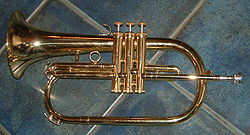Flügelhorn

A standard 3-valved B♭ flugelhorn
|
|
| Brass instrument | |
|---|---|
| Classification | |
| Hornbostel–Sachs classification | 423.232 (Valved aerophone sounded by lip movement) |
| Developed | Early 19th century |
| Playing range | |
| (as written; actually sounds a major second lower) | |
| Related instruments | |
The flugelhorn (/ˈfluːɡəl.hɔːrn/—also spelled fluegelhorn, flugel horn, or Flügelhorn—from German, wing horn, German pronunciation: [ˈflyːɡl̩hɔʁn]) is a brass instrument pitched in B♭, and resembles a trumpet, but has a wider, conical bore. The instrument known today as the flugelhorn was developed from the valved bugle and is a member of the saxhorn family, which was developed by Adolphe Sax, who also created the saxophone family. The modern flugelhorn and Sax's B♭ soprano (contralto) saxhorn are practically the same instrument.
The German word Flügel translates into English as wing or flank. The instrument was used on the battlefield to summon the flanks of an army.
The flugelhorn is built in the same B♭ pitch as many trumpets and cornets. It usually has three piston valves and employs the same fingering system as other brass instruments, but four-piston valve and rotary valve variants also exist. It can thus be played without too much trouble by trumpet and cornet players, though some adaptation to their playing style may be needed. It is usually played with a more deeply conical mouthpiece than either trumpets or cornets (though not as conical as a horn mouthpiece).
...
Wikipedia

